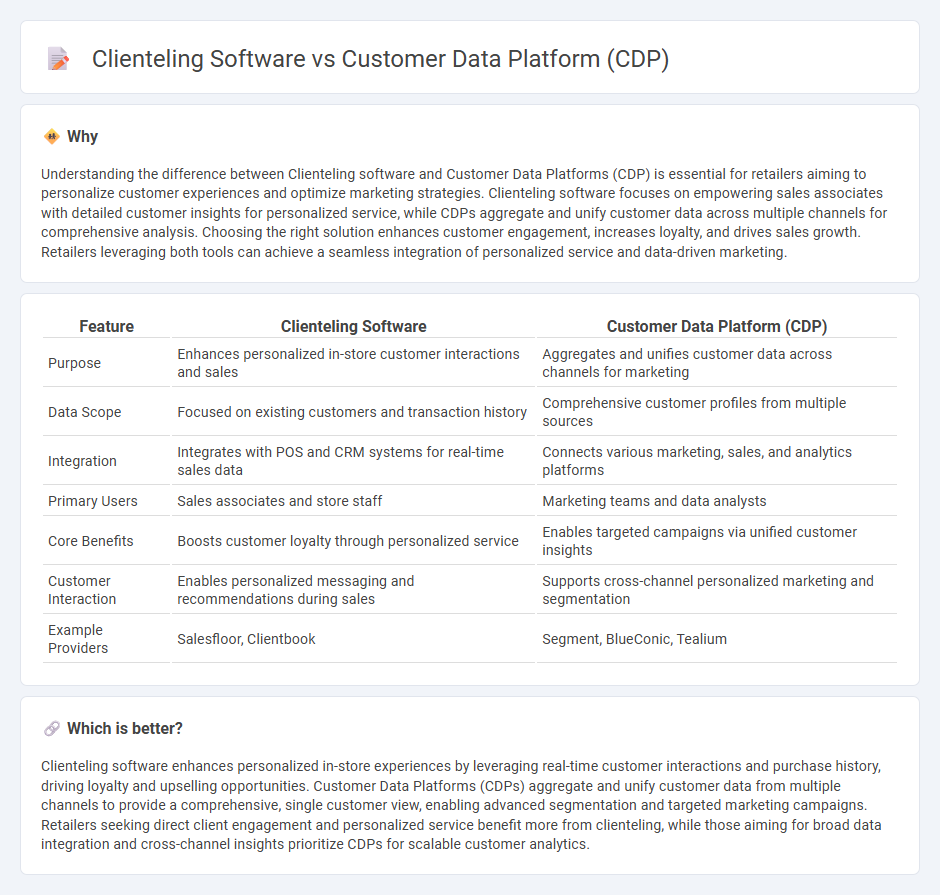
Clienteling software enhances personalized shopping experiences by enabling retail associates to access real-time customer preferences and purchase history, fostering stronger customer relationships. Customer Data Platforms (CDPs) aggregate and unify data from multiple sources, providing a 360-degree view of customer behavior across all touchpoints for advanced segmentation and targeted marketing. Explore how harnessing both tools can revolutionize retail strategies and drive customer loyalty.
Why it is important
Understanding the difference between Clienteling software and Customer Data Platforms (CDP) is essential for retailers aiming to personalize customer experiences and optimize marketing strategies. Clienteling software focuses on empowering sales associates with detailed customer insights for personalized service, while CDPs aggregate and unify customer data across multiple channels for comprehensive analysis. Choosing the right solution enhances customer engagement, increases loyalty, and drives sales growth. Retailers leveraging both tools can achieve a seamless integration of personalized service and data-driven marketing.
Comparison Table
| Feature | Clienteling Software | Customer Data Platform (CDP) |
|---|---|---|
| Purpose | Enhances personalized in-store customer interactions and sales | Aggregates and unifies customer data across channels for marketing |
| Data Scope | Focused on existing customers and transaction history | Comprehensive customer profiles from multiple sources |
| Integration | Integrates with POS and CRM systems for real-time sales data | Connects various marketing, sales, and analytics platforms |
| Primary Users | Sales associates and store staff | Marketing teams and data analysts |
| Core Benefits | Boosts customer loyalty through personalized service | Enables targeted campaigns via unified customer insights |
| Customer Interaction | Enables personalized messaging and recommendations during sales | Supports cross-channel personalized marketing and segmentation |
| Example Providers | Salesfloor, Clientbook | Segment, BlueConic, Tealium |
Which is better?
Clienteling software enhances personalized in-store experiences by leveraging real-time customer interactions and purchase history, driving loyalty and upselling opportunities. Customer Data Platforms (CDPs) aggregate and unify customer data from multiple channels to provide a comprehensive, single customer view, enabling advanced segmentation and targeted marketing campaigns. Retailers seeking direct client engagement and personalized service benefit more from clienteling, while those aiming for broad data integration and cross-channel insights prioritize CDPs for scalable customer analytics.
Connection
Clienteling software and Customer Data Platforms (CDPs) are interconnected through their shared goal of enhancing personalized retail experiences by leveraging unified customer data. Clienteling tools utilize rich data from CDPs, such as purchase history, preferences, and behavioral insights, to empower sales associates with actionable information for targeted engagement. Integrating CDP data into clienteling software enables retailers to deliver customized offers, improve customer loyalty, and increase sales conversions effectively.
Key Terms
Unified Customer Profile
Customer data platforms (CDPs) aggregate and unify customer information from multiple touchpoints, creating comprehensive, real-time unified customer profiles that enhance personalized marketing efforts. Clienteling software leverages these unified profiles to provide sales associates with detailed customer insights, enabling tailored interactions and improved customer loyalty. Discover how integrating CDP and clienteling software can transform personalized customer experiences.
Personalization
Customer Data Platforms (CDPs) aggregate and unify customer information from multiple sources to create comprehensive profiles, enabling highly personalized marketing campaigns. Clienteling software uses this data to empower sales associates with real-time insights, fostering personalized interactions and tailored recommendations during customer engagements. Explore how integrating both solutions can maximize personalization and enhance customer loyalty.
Omnichannel Engagement
Customer Data Platforms (CDPs) centralize and unify customer data from multiple sources to create comprehensive profiles, enabling personalized marketing and data-driven insights across channels. Clienteling software leverages these profiles to empower sales associates with real-time customer information for personalized in-store interactions and loyalty-building. Explore how integrating CDP and clienteling solutions enhances seamless omnichannel engagement and drives customer retention.
Source and External Links
Customer data platform - A CDP is software that creates a unified, persistent customer database by pulling and cleaning data from multiple sources to form a single profile accessible for marketing and analytics, enabling a 360-degree customer view and segmentation capabilities.
What is a customer data platform? (CDP) - MarTech - A CDP is marketer-managed software that unifies known and anonymous customer data in a persistent database, allowing control over data collection, segmentation, and integration with external platforms without heavy IT involvement.
What is a Customer Data Platform (CDP)? | Salesforce US - A CDP technology unifies customer data from all channels in real time to build comprehensive profiles that enhance personalized experiences and support connected marketing campaigns across platforms.
 dowidth.com
dowidth.com